+ Open data
Open data
- Basic information
Basic information
| Entry |  | |||||||||
|---|---|---|---|---|---|---|---|---|---|---|
| Title | BA.2.86 Spike Trimer with ins483V mutation (3 RBD down) | |||||||||
 Map data Map data | ||||||||||
 Sample Sample |
| |||||||||
 Keywords Keywords | Trimer / VIRAL PROTEIN | |||||||||
| Function / homology |  Function and homology information Function and homology informationsymbiont-mediated disruption of host tissue / Maturation of spike protein / Translation of Structural Proteins / Virion Assembly and Release / host cell surface / viral translation / host extracellular space / symbiont-mediated-mediated suppression of host tetherin activity / Induction of Cell-Cell Fusion / structural constituent of virion ...symbiont-mediated disruption of host tissue / Maturation of spike protein / Translation of Structural Proteins / Virion Assembly and Release / host cell surface / viral translation / host extracellular space / symbiont-mediated-mediated suppression of host tetherin activity / Induction of Cell-Cell Fusion / structural constituent of virion / entry receptor-mediated virion attachment to host cell / membrane fusion / Attachment and Entry / host cell endoplasmic reticulum-Golgi intermediate compartment membrane / positive regulation of viral entry into host cell / receptor-mediated virion attachment to host cell / host cell surface receptor binding / symbiont-mediated suppression of host innate immune response / receptor ligand activity / endocytosis involved in viral entry into host cell / fusion of virus membrane with host plasma membrane / fusion of virus membrane with host endosome membrane / viral envelope / symbiont entry into host cell / virion attachment to host cell / SARS-CoV-2 activates/modulates innate and adaptive immune responses / host cell plasma membrane / virion membrane / identical protein binding / membrane / plasma membrane Similarity search - Function | |||||||||
| Biological species |  | |||||||||
| Method | single particle reconstruction / cryo EM / Resolution: 3.49 Å | |||||||||
 Authors Authors | Yue C / Liu P | |||||||||
| Funding support | 1 items
| |||||||||
 Citation Citation |  Journal: Natl Sci Rev / Year: 2024 Journal: Natl Sci Rev / Year: 2024Title: Spike N354 glycosylation augments SARS-CoV-2 fitness for human adaptation through structural plasticity. Authors: Pan Liu / Can Yue / Bo Meng / Tianhe Xiao / Sijie Yang / Shuo Liu / Fanchong Jian / Qianhui Zhu / Yuanling Yu / Yanyan Ren / Peng Wang / Yixin Li / Jinyue Wang / Xin Mao / Fei Shao / Youchun ...Authors: Pan Liu / Can Yue / Bo Meng / Tianhe Xiao / Sijie Yang / Shuo Liu / Fanchong Jian / Qianhui Zhu / Yuanling Yu / Yanyan Ren / Peng Wang / Yixin Li / Jinyue Wang / Xin Mao / Fei Shao / Youchun Wang / Ravindra Kumar Gupta / Yunlong Cao / Xiangxi Wang /   Abstract: Selective pressures have given rise to a number of SARS-CoV-2 variants during the prolonged course of the COVID-19 pandemic. Recently evolved variants differ from ancestors in additional ...Selective pressures have given rise to a number of SARS-CoV-2 variants during the prolonged course of the COVID-19 pandemic. Recently evolved variants differ from ancestors in additional glycosylation within the spike protein receptor-binding domain (RBD). Details of how the acquisition of glycosylation impacts viral fitness and human adaptation are not clearly understood. Here, we dissected the role of N354-linked glycosylation, acquired by BA.2.86 sub-lineages, as a RBD conformational control element in attenuating viral infectivity. The reduced infectivity is recovered in the presence of heparin sulfate, which targets the 'N354 pocket' to ease restrictions of conformational transition resulting in a 'RBD-up' state, thereby conferring an adjustable infectivity. Furthermore, N354 glycosylation improved spike cleavage and cell-cell fusion, and in particular escaped one subset of ADCC antibodies. Together with reduced immunogenicity in hybrid immunity background, these indicate a single spike amino acid glycosylation event provides selective advantage in humans through multiple mechanisms. | |||||||||
| History |
|
- Structure visualization
Structure visualization
| Supplemental images |
|---|
- Downloads & links
Downloads & links
-EMDB archive
| Map data |  emd_38056.map.gz emd_38056.map.gz | 97.1 MB |  EMDB map data format EMDB map data format | |
|---|---|---|---|---|
| Header (meta data) |  emd-38056-v30.xml emd-38056-v30.xml emd-38056.xml emd-38056.xml | 17.9 KB 17.9 KB | Display Display |  EMDB header EMDB header |
| Images |  emd_38056.png emd_38056.png | 73.6 KB | ||
| Filedesc metadata |  emd-38056.cif.gz emd-38056.cif.gz | 6.9 KB | ||
| Others |  emd_38056_half_map_1.map.gz emd_38056_half_map_1.map.gz emd_38056_half_map_2.map.gz emd_38056_half_map_2.map.gz | 95.6 MB 95.6 MB | ||
| Archive directory |  http://ftp.pdbj.org/pub/emdb/structures/EMD-38056 http://ftp.pdbj.org/pub/emdb/structures/EMD-38056 ftp://ftp.pdbj.org/pub/emdb/structures/EMD-38056 ftp://ftp.pdbj.org/pub/emdb/structures/EMD-38056 | HTTPS FTP |
-Validation report
| Summary document |  emd_38056_validation.pdf.gz emd_38056_validation.pdf.gz | 955.4 KB | Display |  EMDB validaton report EMDB validaton report |
|---|---|---|---|---|
| Full document |  emd_38056_full_validation.pdf.gz emd_38056_full_validation.pdf.gz | 955 KB | Display | |
| Data in XML |  emd_38056_validation.xml.gz emd_38056_validation.xml.gz | 13.3 KB | Display | |
| Data in CIF |  emd_38056_validation.cif.gz emd_38056_validation.cif.gz | 15.7 KB | Display | |
| Arichive directory |  https://ftp.pdbj.org/pub/emdb/validation_reports/EMD-38056 https://ftp.pdbj.org/pub/emdb/validation_reports/EMD-38056 ftp://ftp.pdbj.org/pub/emdb/validation_reports/EMD-38056 ftp://ftp.pdbj.org/pub/emdb/validation_reports/EMD-38056 | HTTPS FTP |
-Related structure data
| Related structure data |  8x4zMC 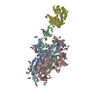 8whsC  8whuC  8whvC 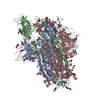 8whwC  8whzC 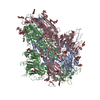 8x4hC 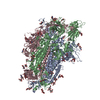 8x50C 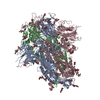 8x55C  8x56C 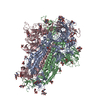 8x5qC 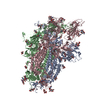 8x5rC  8xurC 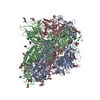 8xusC 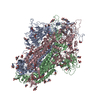 8xutC 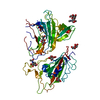 8xuuC M: atomic model generated by this map C: citing same article ( |
|---|---|
| Similar structure data | Similarity search - Function & homology  F&H Search F&H Search |
- Links
Links
| EMDB pages |  EMDB (EBI/PDBe) / EMDB (EBI/PDBe) /  EMDataResource EMDataResource |
|---|---|
| Related items in Molecule of the Month |
- Map
Map
| File |  Download / File: emd_38056.map.gz / Format: CCP4 / Size: 103 MB / Type: IMAGE STORED AS FLOATING POINT NUMBER (4 BYTES) Download / File: emd_38056.map.gz / Format: CCP4 / Size: 103 MB / Type: IMAGE STORED AS FLOATING POINT NUMBER (4 BYTES) | ||||||||||||||||||||||||||||||||||||
|---|---|---|---|---|---|---|---|---|---|---|---|---|---|---|---|---|---|---|---|---|---|---|---|---|---|---|---|---|---|---|---|---|---|---|---|---|---|
| Projections & slices | Image control
Images are generated by Spider. | ||||||||||||||||||||||||||||||||||||
| Voxel size | X=Y=Z: 1.04 Å | ||||||||||||||||||||||||||||||||||||
| Density |
| ||||||||||||||||||||||||||||||||||||
| Symmetry | Space group: 1 | ||||||||||||||||||||||||||||||||||||
| Details | EMDB XML:
|
-Supplemental data
-Half map: #1
| File | emd_38056_half_map_1.map | ||||||||||||
|---|---|---|---|---|---|---|---|---|---|---|---|---|---|
| Projections & Slices |
| ||||||||||||
| Density Histograms |
-Half map: #2
| File | emd_38056_half_map_2.map | ||||||||||||
|---|---|---|---|---|---|---|---|---|---|---|---|---|---|
| Projections & Slices |
| ||||||||||||
| Density Histograms |
- Sample components
Sample components
-Entire : Severe acute respiratory syndrome coronavirus 2
| Entire | Name:  |
|---|---|
| Components |
|
-Supramolecule #1: Severe acute respiratory syndrome coronavirus 2
| Supramolecule | Name: Severe acute respiratory syndrome coronavirus 2 / type: complex / ID: 1 / Parent: 0 / Macromolecule list: #1 |
|---|---|
| Source (natural) | Organism:  |
-Macromolecule #1: Spike glycoprotein
| Macromolecule | Name: Spike glycoprotein / type: protein_or_peptide / ID: 1 / Number of copies: 3 / Enantiomer: LEVO |
|---|---|
| Source (natural) | Organism:  |
| Molecular weight | Theoretical: 134.140281 KDa |
| Recombinant expression | Organism:  Homo sapiens (human) Homo sapiens (human) |
| Sequence | String: ATMFVFLVLL PLVSSQCVMP LFNLITTTQS YTNSFTRGVY YPDKVFRSSV LHLTQDLFLP FFSNVTWFHA ISGTNGTKRF DNPVLPFND GVYFASTEKS NIIRGWIFGT TLDSKTQSLL IVNNATNVFI KVCEFQFCND PFLDVYHKNN KSWMESESGV Y SSANNCTF ...String: ATMFVFLVLL PLVSSQCVMP LFNLITTTQS YTNSFTRGVY YPDKVFRSSV LHLTQDLFLP FFSNVTWFHA ISGTNGTKRF DNPVLPFND GVYFASTEKS NIIRGWIFGT TLDSKTQSLL IVNNATNVFI KVCEFQFCND PFLDVYHKNN KSWMESESGV Y SSANNCTF EYVSQPFLMD LEGKQGNFKN LREFVFKNID GYFKIYSKHT PIIGRDFPQG FSALEPLVDL PIGINITRFQ TL LALNRSY LTPGDSSSGW TAGAADYYVG YLQPRTFLLK YNENGTITDA VDCALDPLSE TKCTLKSFTV EKGIYQTSNF RVQ PTESIV RFPNVTNLCP FHEVFNATRF ASVYAWNRTR ISNCVADYSV LYNFAPFFAF KCYGVSPTKL NDLCFTNVYA DSFV IKGNE VSQIAPGQTG NIADYNYKLP DDFTGCVIAW NSNKLDSKHS GNYDYWYRLF RKSKLKPFER DISTEIYQAG NKPCK GVKG PNCYFPLQSY GFRPTYGVGH QPYRVVVLSF ELLHAPATVC GPKKSTNLVK NKCVNFNFNG LTGTGVLTKS NKKFLP FQQ FGRDIVDTTD AVRDPQTLEI LDITPCSFGG VSVITPGTNT SNQVAVLYQG VNCTEVSVAI HADQLTPTWR VYSTGSN VF QTRAGCLIGA EYVNNSYECD IPIGAGICAS YQTQTKSRRA AASVASQSII AYTMSLGAEN SVAYSNNSIA IPTNFTIS V TTEILPVSMT KTSVDCTMYI CGDSTECSNL LLQYGSFCTQ LKRALTGIAV EQDKNTQEVF AQVKQIYKTP PIKYFGGFN FSQILPDPSK PSKRSPIEDL LFNKVTLADA GFIKQYGDCL GDIAARDLIC AQKFNGLTVL PPLLTDEMIA QYTSALLAGT ITSGWTFGA GPALQIPFPM QMAYRFNGIG VTQNVLYENQ KLIANQFNSA IGKIQDSLFS TPSALGKLQD VVNHNAQALN T LVKQLSSK FGAISSVLND ILSRLDPPEA EVQIDRLITG RLQSLQTYVT QQLIRAAEIR ASANLAATKM SECVLGQSKR VD FCGKGYH LMSFPQSAPH GVVFLHVTYV PAQEKNFTTA PAICHDGKAH FPREGVFVSN GTHWFVTQRN FYEPQIITTD NTF VSGNCD VVIGIVNNTV YDPLQLELDS FKEELDKYFK NHTSPDVDLG DISGINASVV NIQKEIDRLN EVAKNLNESL IDLQ ELGKY EQ UniProtKB: Spike glycoprotein |
-Macromolecule #3: 2-acetamido-2-deoxy-beta-D-glucopyranose
| Macromolecule | Name: 2-acetamido-2-deoxy-beta-D-glucopyranose / type: ligand / ID: 3 / Number of copies: 30 / Formula: NAG |
|---|---|
| Molecular weight | Theoretical: 221.208 Da |
| Chemical component information |  ChemComp-NAG: |
-Experimental details
-Structure determination
| Method | cryo EM |
|---|---|
 Processing Processing | single particle reconstruction |
| Aggregation state | particle |
- Sample preparation
Sample preparation
| Buffer | pH: 7.4 |
|---|---|
| Vitrification | Cryogen name: ETHANE |
- Electron microscopy
Electron microscopy
| Microscope | FEI TITAN |
|---|---|
| Image recording | Film or detector model: GATAN K2 SUMMIT (4k x 4k) / Average electron dose: 60.0 e/Å2 |
| Electron beam | Acceleration voltage: 300 kV / Electron source:  FIELD EMISSION GUN FIELD EMISSION GUN |
| Electron optics | Illumination mode: FLOOD BEAM / Imaging mode: DARK FIELD / Nominal defocus max: 2.0 µm / Nominal defocus min: 1.2 µm |
 Movie
Movie Controller
Controller



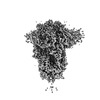





















 Z (Sec.)
Z (Sec.) Y (Row.)
Y (Row.) X (Col.)
X (Col.)




































